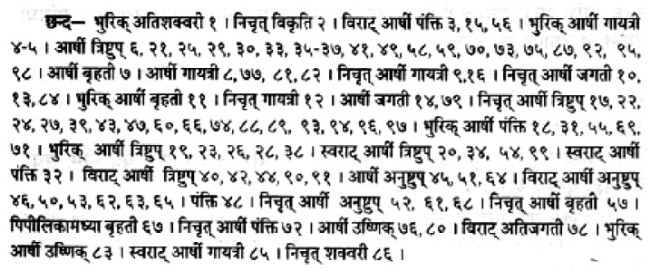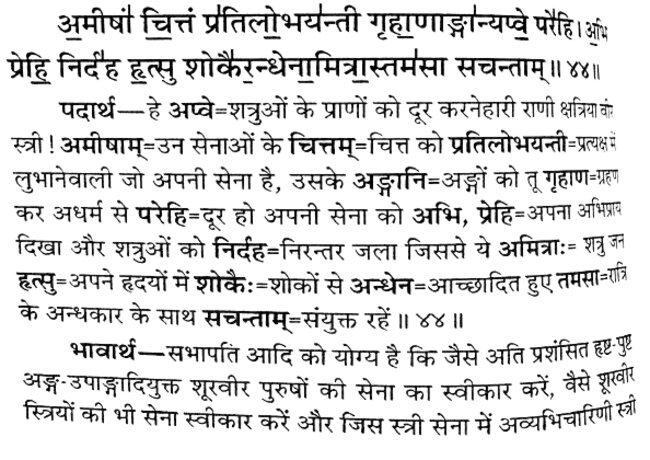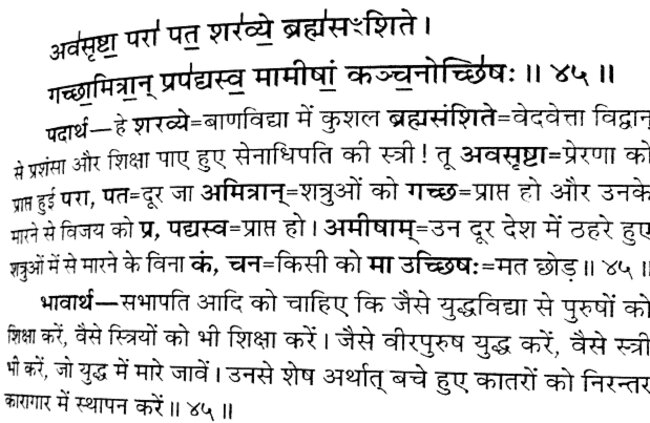
| WOMAN WARRIORS IN VEDS Introducation :
Before going into the topic Women Warrior in Rig Ved it would not be fair on my part if I dont mention the name Ghosha. I (Dr. Gaurav Arunkumar Vyas) represent Gautam Gotra. Rishi Gautam was son of Dirghtamas, Dirghtamas and Kauts were son of Rishi Angiras.
Rishi Gautam also had a brother Kakshivan. Ghosha was his daughter. This in a way makes Ghosha my sister and hence it is her prerogative not only as a part of my family but also because of her achievements that I mention her name.
Another important warrior is wife of Mudgal. Her name was Nalyani Indrasena. She was called Mudgalani i.e. wife of Mudgal.
Mudgal had a Daughter Ahilya who was married to Rishi Gautam.
To know more about Rishi Mudgal Click here.
During Vedic times women also wrote vedic mantras and also took part in war. Women of the Vedic period were examples of spiritual attainment. They were revealers of Brahman and learners of the Veds sometimes even composing some of the hymns. They were highly spiritually exalted and their knowledge and wisdom were on par or sometimes even greater than their male counterparts. They embraced simple living and high thinking. Some of them were wives or children of great Rishis.
Ghosha :
Ghosha was an ancient Vedic period Indian female philosopher and seer. From a young age she suffered from a skin ailment which had disfigured her. Ashvini Kumars cured her and restored her youthfulness, health and beauty. As a result, she got married and had a son. She was proficient in the Veds and had even scripted two hymns in the Rigved. She was called as mantradrik meaning well versed in mantras. She was also known as a Brahmavadini or speaker or proclaimer of Brahman and led a purposeful spiritual life.
Biography
:
Ghosha
composed two hymns in praise of the Ashvini Kumars which are contained
in two suktas (hymns) of the tenth Mandal (book) of Rigved, chapter
X hymns 39 and 40, each containing 14 verses. The first hymn praises
the Ashvins. The second hymn is a personal desire expressing her
intimate feelings and desires for married life. The two hymns are:
[citation needed]
Where are you, Asvins, in the evening, where at morn? Where is your halting place, where rest ye for the night? O Heroes, this I beg of you. 'Be near me in the day, be near me in the night'.
Birth and Early Living :
Ghosha was the daughter of Rishi Kakshivan who was a descendent of Angiras and granddaughter of Dirgatamas. As she suffered from a skin ailment (leprosy) from childhood she was unable to get married. She dutifully served her father but continuously prayed to the Ashvini Kumars the divine physicians who were endowed with the power of rejuvenation. Pleased with her deep and sincere prayers the Ashvini Kumars taught her Madhu Vidya, the Science of secret learning which granted her youth and great knowledge and cured her of her ailment due to which she subsequently got a worthy husband. She composed two Rig Ved hymns 39, 49 of Mandal ten each containing 14 verses. The first eulogises the Ashvini Devtas and the second is a personal wish expressing her intimate desires and feelings for married life. Her son Suhastya also composed a hymn in the Rig Ved.
Gosha is revered as one of the woman seers of Vedic India, a Rishika who was highly knowledgeable and proficient in the Vedas and even composed a few hymns. She was a Brahmavadini or speaker or revealer of Brahman and lived a highly spiritual life and has been recorded in the annals of ancient Vedic history as one of the famous woman seers along with Gargi, Lopamudra , Maitreyi etc.
Rishika :
Rishika means female Rishi.
The term Rishi was used for the Vedic hymn writers during the Vedic age. The Rishis were basically the creators or composers of Veds. Various females Rishikas are mentioned in Rig Ved and Sam Ved as a contributor to Vedic scriptures. Viswavara, Apala and Ghosha alongwith Lopamudra, Devayani etc are mentioned in Rig Ved.
One or more mantra was revealed to each Rishika.
Following are the Verse and their Rishika :
Mention of Woman warrior Vishpala in Rig Ved :
Vedic Hymn (mantra) :
In Rig Ved there is mention of women warriors. Ashwinikumars were Doctor of Devtas.
1. RV 1.112.10 (Rig Ved Mandal 1, Sukt 112, Mantra 10 i.e. 1220) :
Rig Ved Hymn (mantra) 10 i.e. 1220 This Hymn (mantra) is written by Kuts son of Angiras Translation in English :
O Ashwini Kumars, by the ability with which you both you had assisted in the battle field wealth giving Vishpala born in the Atharv lineage where thousands of warriors were fighting and protected Vash Rishi son of inspiring Ashvaraj, with the same protection capabilities you certainly come to us.
2. RV 1.116.15 (Rig Ved Mandal 1, Sukt 116, Mantra 15 i.e. 1287) :
Rig Ved Hymn (mantra) 15 i.e. 1287 This Hymn (mantra) is written by Kakshivan son of Dirghtamas Translation :
As a wing of bird falls same way Vishpala lady who was related to King Khel her leg was cut in war. During night time you two (here it says about Ashwini kumars) attached a Iron thigh so that after war starts she can attack.
Meaning :
The above Hymn (mantra) is written by Kakshivan who was son of Dirghtamas and this entire incident where the Ashvini Kumars attached a Iron Thigh happened in front of him (Kakshivan).
Kakshivan was brother of Rishi Gautam, their father was Dirghtamas and Dirghtamas was Rishi Angiras. Kakshivan, Gautam, Dirghtamas, Angiras, etc. were Brahmins and have written Hyms of Rig, Sam, Yajur and Atharv Ved.
3. RV 1.117.11 (Rig Ved Mandal 1, Sukt 117, Mantra 11 i.e. 1308) :
This Hymn (mantra) is written by Kakshivan son of Dirghtamas (aushij) Translation :
O nurturer of all, full of truth Ashwinikumar. Maan prayed to you both for attaining son and you granted him capability to attain son. On the prayer of Rishi Agastya you healed amputated leg of Vishpala.
4. RV 1.118.8 (Rig Ved Mandal 1, Sukt 118, Mantra 8 i.e. 1330) :
This Hymn (mantra) is written by Kakshivan son of Dirghtamas Translation :
O Ashwinikumars you both ancient times for Yajya host (yajman) named Shayu you made cow capable of producing milk, you released Quail from the mouth of wolf and replaced amputated leg of Vishpala with iron leg by proper treatment (shalya kriya).
5. RV 10.39.8 (Rig Ved Mandal 10, Sukt 39, Mantra 8 i.e. 9203) :
This Hymn (mantra) is written by Ghosha daughter of Kakshivan Translation :
O Ashwinikumars you granted youth to Rishi who had dilapidated body. You brought out Rishi Vandan from well who was in sorrow because of death of his wife. Same way you provided iron leg to lame Vishpala and made her capable of walking.
[In ancient times restoring youth and Artifical limb surgery knowledge can be seen from these hymns (mantras).
Above Rig Ved Hymns (mantras ) summarization :
Other Rig Ved Mantras :
6. RV 10.102.2 (Rig Ved Mandal 10, Sukt 102, Mantra 2) :
Translation :
At the time when Mudgals wife (mudgalani) drove chariot and was going to win cows at that time her clothes were taken care / handled by wind. At the time of winning cows Mudgals wife became Rathi (The owner of or the rider in chariot). Mudgals wife Indrasena at the time of war snached and brought cows from the hands of enemy.
Points :
This proves that in Ancient women used to ride chariots and take part in war.
7. RV 10.102.6 (Rig Ved Mandal 10, Sukt 102, Mantra 6) :
Translation :
The bull has been yoked for the destruction of the enemy; his long-haired yoke-fellow made him roar; rushing on with the waggon of the irresistible yoked (bull), the warriors come forth went to mudgalani (Indrasena).
8. RV 5.30.9 (Rig Ved Mandal 5, Sukt 30, Mantra 9 i.e. 3863 ) :
This Hymn (mantra) is written by Vabhu son of Aatreya Translation :
When Das Namuchi used women in war that time what will his this weak army do? thinking this Indra Dev took his 2 main women as prisoner and moved forward to fight namuchi.
Points :
The above Mantra proves that there was a Women army / brigade during Vedic times. People with Das surname are still found in Bharat specially Eastern side of Bharat like Bengal and Assam. I am not sure if these people belong to Das tribe or not.
To know more about Das tribe mentioned in Rig Ved Click here.
To know more about Aatreya Click here.
The above mantras can be related to Dasharajnya or ‘Battle of ten Kings or Varshagir war mentioned in Rig Ved.
9. YV Sukt 17.44 and 45 (Yajur Ved, Sukt 17, Mantra 44 and 45) :
Yajur ved Sukt 17.44 (Yajur Ved, Sukt 17, Mantra 44) :
Translation :
It is appropriate for Chairman / chairperson, etc that just like he accepts highly acclaimed well built and with complete body brave men's army in the same way he should accept the brave women army and in the army of women, which has a woman sorcerous from that army establish control over enemy.
Point :
The above mantra (hymn) proves that there was a women army which also had woman sorcerous.
10. YV Sukt 17.45 (Yajur Ved, Sukt 17, Mantra 45) :
Translation :
Chairman / chairperson needs that the way in which they have trained men in the same way they should train women in the science of war. The way brave men fights in war the same way women also fights in war and dies. From those (warriors) who are left alive arrange them constantly and effectively in que.
Point :
The above mantra (hymn) proves that women were also trained as men in science of war, they fought and died same way brave men fought and died. |
||||||||||||||||||||||||||||||||||||||||||||||||||||||||||||||||||||||||||






















